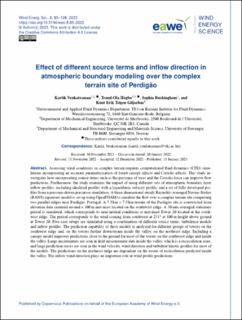| dc.contributor.author | Venkatraman, Kartik | |
| dc.contributor.author | Hågbo, Trond-Ola | |
| dc.contributor.author | Buckingham, Sophia | |
| dc.contributor.author | Giljarhus, Knut Erik Teigen | |
| dc.date.accessioned | 2023-04-21T13:32:45Z | |
| dc.date.available | 2023-04-21T13:32:45Z | |
| dc.date.created | 2023-01-17T09:56:41Z | |
| dc.date.issued | 2023 | |
| dc.identifier.citation | Venkatraman, K., Hågbo, T. O., Buckingham, S., & Teigen Giljarhus, K. E. (2023). Effect of different source terms and inflow direction in atmospheric boundary modeling over the complex terrain site of Perdigão. Wind Energy Science, 8 (1), 85-108. | en_US |
| dc.identifier.issn | 2366-7443 | |
| dc.identifier.uri | https://hdl.handle.net/11250/3064296 | |
| dc.description.abstract | Assessing wind conditions in complex terrain requires computational fluid dynamics (CFD) simulations incorporating an accurate parameterization of forest canopy effects and Coriolis effects. This study investigates how incorporating source terms such as the presence of trees and the Coriolis force can improve flow predictions. Furthermore, the study examines the impact of using different sets of atmospheric boundary layer inflow profiles, including idealized profiles with a logarithmic velocity profile, and a set of fully developed profiles from a pressure-driven precursor simulation. A three-dimensional steady Reynolds-averaged Navier–Stokes (RANS) equations model is set up using OpenFOAM to simulate the flow over a complex terrain site comprising two parallel ridges near Perdigão, Portugal. A 7.5 km×7.5 km terrain of the Perdigão site is constructed from elevation data centered around a 100 m met-mast located on the southwest ridge. A 30 min averaged stationary period is simulated, which corresponds to near-neutral conditions at met-mast Tower 20 located at the southwest ridge. The period corresponds to the wind coming from southwest at 231∘ at 100 m height above ground at Tower 20. Five case setups are simulated using a combination of different source terms, turbulence models and inflow profiles. The prediction capability of these models is analyzed for different groups of towers on the southwest ridge and, on the towers further downstream inside the valley, on the northeast ridge. Including a canopy model improves predictions close to the ground for most of the towers on the southwest ridge and inside the valley. Large uncertainties are seen in field measurement data inside the valley, which is a recirculation zone, and large prediction errors are seen in the wind velocity, wind direction and turbulent kinetic profiles for most of the models. The predictions on the northeast ridge are dependent on the extent of recirculation predicted inside the valley. The inflow wind direction plays an important role in wind profile predictions. | en_US |
| dc.language.iso | eng | en_US |
| dc.publisher | Copernicus Publications | en_US |
| dc.relation.uri | https://wes.copernicus.org/articles/8/85/2023/ | |
| dc.rights | Navngivelse 4.0 Internasjonal | * |
| dc.rights.uri | http://creativecommons.org/licenses/by/4.0/deed.no | * |
| dc.title | Effect of different source terms and inflow direction in atmospheric boundary modeling over the complex terrain site of Perdigão | en_US |
| dc.title.alternative | Effect of different source terms and inflow direction in atmospheric boundary modeling over the complex terrain site of Perdigão | en_US |
| dc.type | Peer reviewed | en_US |
| dc.type | Journal article | en_US |
| dc.description.version | publishedVersion | en_US |
| dc.rights.holder | The authors | en_US |
| dc.subject.nsi | VDP::Teknologi: 500 | en_US |
| dc.source.pagenumber | 85-108 | en_US |
| dc.source.volume | 8 | en_US |
| dc.source.journal | Wind Energy Science | en_US |
| dc.source.issue | 1 | en_US |
| dc.identifier.doi | 10.5194/wes-8-85-2023 | |
| dc.identifier.cristin | 2108278 | |
| dc.relation.project | Norges forskningsråd: 280458 | en_US |
| cristin.ispublished | true | |
| cristin.fulltext | original | |
| cristin.qualitycode | 1 | |

